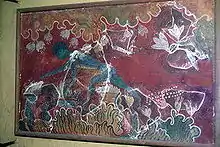History of saffron
Human cultivation and use of saffron spans more than 3,500 years[1][2] and extends across cultures, continents, and civilizations. Saffron, a spice derived from the dried stigmas of the saffron crocus (Crocus sativus), has through history remained among the world's most costly substances. With its bitter taste, hay-like fragrance, and slight metallic notes, the apocarotenoid-rich saffron has been used as a seasoning, fragrance, dye, and medicine.
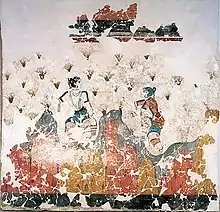
The wild precursor of domesticated saffron crocus was likely Crocus cartwrightianus, which originated in Crete or Central Asia;[3] C. thomasii and C. pallasii are other possible sources.[4][5] Although some doubts remain on its origin,[6] it is believed that saffron originated in Iran (Persia).[7] However, Greece,[8] Mesopotamia,[9] and even Kashmir[10] have also been suggested as the possible region of origin of this plant. The saffron crocus is now a triploid that is "self-incompatible" and male sterile; it undergoes aberrant meiosis and is hence incapable of independent sexual reproduction—all propagation is by vegetative multiplication via manual "divide-and-set" of a starter clone or by interspecific hybridisation.[11][5] If C. sativus is a mutant form of C. cartwrightianus, then it may have emerged via plant breeding, which would have selected for elongated stigmas, in late Bronze Age Crete.[12]
Humans may have bred C. cartwrightianus specimens by screening for specimens with abnormally long stigmas. The resulting saffron crocus was documented in a 7th-century BC Assyrian botanical reference compiled under Ashurbanipal,[13] and it has since been traded and used over the course of four millennia and has been used as treatment for some ninety disorders.[14] The C. sativus clone was slowly propagated throughout much of Eurasia, later reaching parts of North Africa, North America, and Oceania.
Etymology
The word "saffron" immediately stems from the Latin word safranum via the 12th-century Old French term safran. The French was borrowed from Arabic زَعْفَرَان (za'farān), and ultimately from Persian زَرپَران (zarparān) which literally means "golden leaves".
The Latin form safranum is also the source of the Catalan safrà, Italian zafferano,[15] but Portuguese açafrão, and Spanish azafrán come from the Arabic az-zaferán.
The Latin term crocus is certainly a Semitic loanword. It is adapted from the Aramaic form kurkema via the Arabic term kurkum and the Greek intermediate κρόκος krokos, which once again signifies "yellowish".[16][17] The Sanskrit kunkumam might be ultimately the origin, or in some way related to the Semitic term.[15]
Minoan and Greco-Roman
Crocus cartwrightianus is a species of flowering plant in the family Iridaceae, native to Greece and Crete. C. cartwrightianus is the presumed wild progenitor of the domesticated triploid Crocus sativus – the saffron crocus.[20] Saffron is the triploid form of a species found in Eastern Greece, Crocus cartwrightianus; it probably appeared first in Crete. An origin in Western or Central Asia, although often suspected, has been disproved by botanical research.[21]
Saffron played a significant role in the Greco-Roman pre-classical period bracketed by the 8th century BC and the 3rd century AD.[22] The first known image of saffron in pre-Greek culture is much older and stems from the Bronze Age. A saffron harvest is shown in the Knossos palace frescoes of Minoan Crete,[23] which depict the flowers being picked by young girls and monkeys. One of these fresco sites is located in the "Xeste 3" building at Akrotiri, on the Aegean island of Santorini—the ancient Greeks knew it as "Thera". These frescoes likely date from the 16th[14] or 17th century BC[24] but may have been produced anywhere between 3000 and 1100 BC.[25] They portray a Minoan goddess supervising the plucking of flowers and the gleaning of stigmas for use in the manufacture of what is possibly a therapeutic drug.[25] A fresco from the same site also depicts a woman using saffron to treat her bleeding foot.[14] These "Theran" frescoes are the first botanically accurate visual representations of saffron's use as an herbal remedy.[25] This saffron-growing Minoan settlement was ultimately destroyed by a powerful earthquake and subsequent volcanic eruption sometime between 1645 and 1500 BC. The volcanic ash from the destruction entombed and helped preserve these key herbal frescoes.[26]
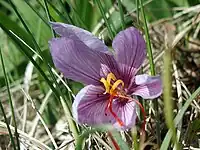

Ancient Greek legends tell of brazen sailors embarking on long and perilous voyages to the remote land of Cilicia, where they traveled to procure what they believed was the world's most valuable saffron.[27] The best-known Hellenic saffron legend is that of Crocus and Smilax: The handsome youth Crocus sets out in pursuit of the nymph Smilax in the woods near Athens; in a brief dallying interlude of idyllic love, Smilax is flattered by his amorous advances, but all too soon tires of his attentions. He continues his pursuit; she resists. She bewitches Crocus: he is transformed—into a saffron crocus. Its radiant orange stigmas were held as a relict glow of an undying and unrequited passion.[28] The tragedy and the spice would be recalled later:
Crocus and Smilax may be turn'd to flow'rs,
And the Curetes spring from bounteous show'rs
I pass a hundred legends stale, as these,
And with sweet novelty your taste to please.[29]
In another variation, Crocus was the lover of the messenger god Hermes. Hermes accidentally killed his lover during a game with the discus, and thus turned the dying Crocus into a saffron flower, in an aetiological myth explaining the origin of the plant.[30]
For the ancient Mediterraneans, saffron gathered around the Cilician coastal town of Soli was of top value, particularly for use in perfumes and ointments. Herodotus and Pliny the Elder, however, rated rival Assyrian and Babylonian saffron from the Fertile Crescent as best—to treat gastrointestinal or renal upsets.[22] Greek saffron from the Corycian Cave of Mount Parnassus was also of note:[31] the color offered by the Corycian crocus is used as a benchmark in the Argonautica of Apollonius Rhodius[N 1] and similarly with its fragrance in the epigrams of Martial.[32]
Cleopatra of late Ptolemaic Egypt used a quarter-cup of saffron in her warm baths, as she prized its colouring and cosmetic properties. She used it before encounters with men, trusting that saffron would render lovemaking yet more pleasurable.[33] Egyptian healers used saffron as a treatment for all varieties of gastrointestinal ailments: when stomach pains progressed to internal hemorrhaging, an Egyptian treatment consisted of saffron crocus seeds mixed and crushed together with aager-tree remnants, ox fat, coriander, and myrrh. This ointment or poultice was applied to the body. The physicians expected it to "[expel] blood through the mouth or rectum which resembles hog's blood when it is cooked".[34] Urinary tract conditions were also treated with an oil-based emulsion of premature saffron flowers mixed with roasted beans; this was used topically on men. Women ingested a more complex preparation.[35]
In Greco-Roman times saffron was widely traded across the Mediterranean by the Phoenicians. Their customers ranged from the perfumers of Rosetta, in Egypt, to physicians in Gaza to townsfolk in Rhodes, who wore pouches of saffron in order to mask the presence of malodorous fellow citizens during outings to the theatre.[36] For the Greeks, saffron was widely associated with professional courtesans and retainers known as the hetaerae. Large dye works operating in Sidon and Tyre used saffron baths as a substitute; there, royal robes were triple-dipped in deep purple dyes; for the robes of royal pretenders and commoners, the last two dips were replaced with a saffron dip, which gave a less intense purple hue.[37]
The ancient Greeks and Romans prized saffron as a perfume or deodoriser and scattered it about their public spaces: royal halls, courts, and amphitheatres alike. When Nero entered Rome they spread saffron along the streets; wealthy Romans partook of daily saffron baths. They used it as mascara, stirred saffron threads into their wines, cast it aloft in their halls and streets as a potpourri, and offered it to their deities. Roman colonists took saffron with them when they settled in southern Roman Gaul, where it was extensively cultivated until the AD 271 barbarian invasion of Italy. Competing theories state that saffron only returned to France with 8th-century Moors or with the Avignon Papacy in the 14th century.[38]
Middle Eastern and Persian
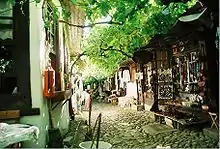
Saffron-based pigments have been found in the prehistoric paints used to illustrate beasts in 50,000-year-old cave art found in modern-day Iraq, which was even then northwest of the Persian Empire.[28][39] The Sumerians used saffron as an ingredient in their remedies and magical potions. Sumerians did not cultivate saffron. They gathered their stores from wild flowers, believing that divine intervention alone enables saffron's medicinal properties.[40] Such evidence suggests that saffron was an article of long-distance trade before Crete's Minoan palace culture reached a peak in the 2nd millennium BC. Saffron was also honoured as a sweet-smelling spice over three millennia ago in the Hebrew Tanakh:
Your lips drop sweetness like honeycomb, my bride, syrup and milk are under your tongue, and your dress had the scent of Lebanon. Your cheeks are an orchard of pomegranates, an orchard full of rare fruits, spikenard and saffron, sweet cane and cinnamon.[41]
According to the Talmud saffron was also among the spices used in the Ketoret offered in the Temple in Jerusalem.[42]
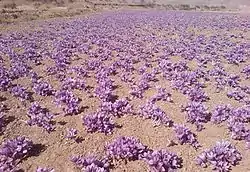
In ancient Persia, saffron (Crocus sativus 'Hausknechtii') was cultivated at Derbena and Isfahan in the 10th century BC. There, Persian saffron threads have been found interwoven into ancient Persian royal carpets and funeral shrouds.[28] Saffron was used by ancient Persian worshippers as a ritual offering to their deities, and as a brilliant yellow dye, perfume, and a medicine. Thus, saffron threads would be scattered across beds and mixed into hot teas as a curative for bouts of melancholy. Indeed, Persian saffron threads, used to spice foods and teas, were widely suspected by foreigners of being a drugging agent and an aphrodisiac. These fears grew to forewarn travelers to abstain from eating saffron-laced Persian cuisine.[22] In addition, Persian saffron was dissolved in water with sandalwood to use as a body wash after heavy work and perspiration under the hot Persian sun.[43] Later, Persian saffron was heavily used by Alexander the Great and his forces during their Asian campaigns. They mixed saffron into teas and dined on saffron rice. Alexander personally used saffron sprinkled in warm bath water, taking after Cyrus the Great. Much like Cyrus, he believed it would heal his many wounds, and his faith in saffron grew with each treatment. He even recommended saffron baths for the ordinary men under him. The Greek soldiers, taken with saffron's perceived curative properties, continued the practice after they returned to Macedonia.[44]
East and South Asian

Various conflicting accounts exist that describe saffron's first arrival in South and East Asia. The first of these rely on historical accounts gleaned from Persian records. These suggest to many experts that saffron, among other spices, was first spread to India via Persian rulers' efforts to stock their newly built gardens and parks. They accomplished this by transplanting the desired cultivars across the Persian empire.[45] Phoenicians then began in the 6th century BC to market the new Kashmiri saffron by utilising their extensive trade routes. Once sold, Kashmiri saffron was used in the treatment of melancholy and as a fabric dye.[22]
On the other hand, traditional Kashmiri legend states that saffron first arrived in the 11th or 12th century AD, when two foreign and itinerant Sufi ascetics, Khwaja Masood Wali and Hazrat Sheikh Shariffudin, wandered into Kashmir. The foreigners, having fallen sick, beseeched a cure for illness from a local tribal chieftain. When the chieftain obliged, the two holy men reputedly gave them a saffron crocus bulb as payment and thanks. To this day, grateful prayers are offered to the two saints during the saffron harvesting season in late autumn. The saints, indeed, have a golden-domed shrine and tomb dedicated to them in the saffron-trading village of Pampore, India. However, the Kashmiri poet and scholar Mohammed Yusuf Teng disputes this. He states that Kashmiris had cultivated saffron for more than two millennia. [46]
Ancient Chinese Buddhist accounts from the mula-sarvastivadin[47] monastic order (or vinaya) present yet another account of saffron's arrival in India. According to legend, an arhat Indian Buddhist missionary by the name of Madhyântika (or Majjhantika) was sent to Kashmir in the 5th century BC. Upon his arrival he seemingly sowed the first Kashmiri saffron crop.[48] From there, saffron use spread throughout the Indian subcontinent. In addition to use in foods, saffron stigmas were also soaked in water to yield a golden-yellow solution that was used as a fabric dye.
Some historians believe that saffron first came to China with Mongol invaders by way of Persia. Saffron is mentioned in the ancient Chinese medical text Shennong Ben Cao Jing, believed to be from the 3rd century AD (but attributed to mythological emperor Shennong). Yet the Chinese were referring to saffron as having a Kashmiri provenance. The Chinese medical expert Wan Zhen wrote that "[t]he habitat of saffron is in Kashmir, where people grow it principally to offer it to the Buddha". Wan reflected on how saffron was used in his time: "The [saffron crocus] flower withers after a few days, and then the saffron is obtained. It is valued for its uniform yellow colour. It can be used to aromatise wine."[48]
In modern times saffron cultivation has spread to Afghanistan due to the efforts of the European Union and the United Kingdom. Together they promote saffron cultivation among impoverished and cash-strapped Afghan farmers as an ideal alternative to lucrative—and illicit—opium production.[49]
Post-Classical European

Saffron cultivation in Europe declined steeply following the fall of the Roman Empire. For several centuries thereafter, saffron cultivation was rare or non-existent throughout Europe. This was reversed when Moorish civilisation spread from North Africa to settle the Iberian peninsula as well as parts of France and southern Italy. One theory states that Moors reintroduced saffron corms to the region around Poitiers after they lost the Battle of Tours to Charles Martel in AD 732.[50] Two centuries after their conquest of Spain, Moors planted saffron throughout the southern provinces of Andalucia, Castile, La Mancha, and Valencia.[50]
In France, saffron cultivation probably started during the 13th century.[51] Crocus sativus was likely introduced from Spain and from the Middle-East by pilgrims, merchants, and Knights. Its first uses are documented in the south-west of the Kingdom around 1250.[51] It is indeed unlikely that the kings and religious orders didn't try growing Crocus sativus by that time: Saffron was rare, expensive, and demanded, and Crocus sativus could be farmed under France's latitudes.[51] By the 14th century, the wide use of saffron for spicing and coloring food is documented in recipe books such as the "Viandier de Taillevent", written by the King's cook.[51] And by the 15th century, local saffron farming is attested with taxes levied by the religious power, which reveal how important saffron crops must have been. For instance, in 1478, the saffron tax levied by the Bishop of Albi reached 1/12th of saffron production.[51]
Saffron demand skyrocketed when the Black Death of 1347–1350 struck Europe. It was coveted by plague victims for medicinal purposes, and yet many of the farmers capable of growing it had died off. Large quantities of non-European saffron were therefore imported.[52] The finest saffron threads from Muslim lands were unavailable to Europeans because of hostilities stoked by the Crusades, so Rhodes and other places were key suppliers to central and northern Europe. Saffron was one of the contested points of hostility that flared between the declining landed gentry and upstart and increasingly wealthy merchants. The fourteen-week-long "Saffron War" was ignited when one 800 lb (363 kg) shipment of saffron was hijacked and stolen by nobles.[52] The load, which was en route to the town of Basel, would at today's market prices be valued at more than US$500,000.[53] That shipment was eventually returned, but the wider 13th–century trade was subject to mass piracy. Thieves plying Mediterranean waters would often ignore gold stores and instead steal Venetian- and Genoan-marketed saffron bound for Europe. Wary of such unpleasantness, Basel planted its own corms. Several years of large and lucrative saffron harvests made Basel extremely prosperous compared to other European towns. Citizens sought to protect their status by outlawing the transport of corms out of the town; guards were posted to prevent thieves from picking flowers or digging up corms. Yet ten years later the saffron harvest had waned. Basel abandoned the crop.[54]
The pivot of central European saffron trade moved to Nuremberg. The merchants of Venice continued their rule of the Mediterranean sea trade, trafficking varieties from Sicily, France and Spain, Austria, Crete and Greece, and the Ottoman Empire. Adulterated goods also made the rounds: those soaked in honey, mixed with marigold petals, or kept in damp cellars—all to add quick and cheap bulk. Irritated Nuremberg authorities passed the Safranschou code to de-louse the saffron trade.[55] Adulterators were thus fined, imprisoned, and executed—by immolation.[56] England was next to have its turn as a major producer. One theory[57] has it that the crop spread to the coastal regions of eastern England in the 14th century AD during the reign of Edward III. In subsequent years saffron was fleetingly cultivated throughout England. Norfolk, Suffolk, and south Cambridgeshire were especially affected with corms. Rowland Parker provides an account of its cultivation in the village of Foxton during the 16th and 17th centuries, "usually by people holding a small amount of land"; an acre planted in saffron could yield a crop worth a kingly £6, making it "a very profitable crop, provided that plenty of unpaid labor was available; unpaid labor was one of the basic features of farming then and for another two centuries."[58]
In France, saffron production became very important in the 17th and 18th centuries, reaching a few tons.[59] By then, saffron farming had spread throughout the entire Kingdom. Saffron was especially grown in Albigeois, Angoumois, Gascony, Gâtinais, Normandy, Périgord, Poitou, Provence, and Quercy.[59] Its mysterious decline started during the 18th century, possibly due to pandemic fungal diseases destroying bulbs and crops, to particularly cold winters, and to competing market from the Mediterranean countries.[59]
In England, cultivation persisted only in the light, well-drained, and chalk-based soils of the north Essex countryside. The Essex town of Saffron Walden got its name as a saffron growing and trading centre; its name was originally Cheppinge Walden, and the culinary name change was effected to punctuate the importance of the crop to the townsfolk; the town's arms still feature blooms from the eponymous crocus.[N 2] Yet as England emerged from the Middle Ages, rising puritanical sentiments and new conquests abroad endangered English saffron's use and cultivation. Puritanical partisans favoured increasingly austere, unadorned, and unspiced foods. Saffron was also a labor-intensive crop, which became an increasing disadvantage as wages and time opportunity costs rose. And finally, an influx of more exotic spices from the far East due to the resurgent spice trade meant that the English, as well as other Europeans, had many more—and cheaper—seasonings to dally over.[60]
This trend was documented by the Dean of Manchester, Reverend William Herbert. He collected samples and compiled information on many aspects of the saffron crocus.[61] He was concerned about the steady decline in saffron cultivation over the course of the 17th century and the dawn of the Industrial Revolution; the introduction in Europe of easily grown maize and potatoes, which steadily took over lands formerly flush with corms, did not help.[62] In addition, the elite who traditionally comprised the bulk of the saffron market were now growing increasingly interested in such intriguing new arrivals as chocolate, coffee, tea, and vanilla. Only in the south of France or in Italy and Spain, where the saffron harvest was culturally primal, did significant cultivation prevail.[62]
North American
Saffron made its way to the New World when thousands of Alsatian, German, and Swiss Anabaptists, Dunkards, and others fled religious persecution in Europe.[63] They settled mainly in eastern Pennsylvania, in the Susquehanna River valley.[64] These settlers, who became known as the Pennsylvania Dutch, were by 1730 widely cultivating saffron after corms were first brought to America—in a trunk. It was owned by German adherents of a Protestant church known as the Schwenkfelder Church. Schwenkfelders, as members were known, were great lovers of saffron, and had grown it back in Germany.[65] Pennsylvania Dutch saffron was soon being successfully marketed to Spanish colonists in the Caribbean, while healthy demand elsewhere ensured that its listed price on the Philadelphia commodities exchange was set equal to that of gold.[66]
However the War of 1812 destroyed many of the merchantmen that ferried American saffron abroad. Pennsylvanian saffron growers were afterwards left with surplus inventory, and trade with the Caribbean markets never recovered.[67] Nevertheless, Pennsylvania Dutch growers developed many uses for the now abundant saffron in their own home cooking—cakes, noodles, and chicken or trout dishes.[68] Saffron cultivation survived into modern times principally in Lancaster County, Pennsylvania.[65]
Notes
- Argonautica of Apollonius Rhodius at Project Gutenberg.
- Image at the town council website of Saffron Walden.
Citations
- Deo 2003, p. 1.
- Hogan 2007.
- Rubio-Moraga et al. 2009.
- Negbi 1999, p. 28.
- Grilli Caiola 2003, p. 1.
- "Saffron, an alternative crop for sustainable agricultural systems.Areview". HAL: 95. 2008. Archived from the original on 20 September 2022. Retrieved 5 February 2019.
- Lichtfouse, Eric (13 July 2017). Sustainable Agriculture Reviews. Springer. p. 170. ISBN 9783319586793. Archived from the original on 19 January 2023. Retrieved 12 July 2022.
- "Saffron, an alternative crop for sustainable agricultural systems.Areview". HAL: 95. 2008. Archived from the original on 20 September 2022. Retrieved 5 February 2019.
- Lichtfouse, Eric (13 July 2017). Sustainable Agriculture Reviews. Springer. p. 171. ISBN 9783319586793. Archived from the original on 19 January 2023. Retrieved 12 July 2022.
- Saffron : science, technology and health. A. Koocheki, Mohammad Khajeh-Hosseini. Duxford, United Kingdom. 2020. ISBN 978-0-12-818740-1. OCLC 1140113593. Archived from the original on 19 January 2023. Retrieved 28 March 2022.
{{cite book}}: CS1 maint: location missing publisher (link) CS1 maint: others (link) - Negbi 1999, p. 30–31.
- Negbi 1999, p. 1.
- Russo, Dreher & Mathre 2003, p. 6.
- Honan 2004.
- Harper 2001.
- Klein 1987, p. 287.
- Kafi et al. 2006, p. 23.
- Hood 1992, pp. 48–49.
- Platon 1947, pp. 505–506.
- Grilli Caiola 2003.
- Mathew 1977.
- Willard 2002, p. 41.
- Hogan 2007, p. 3.
- Dalby 2002, p. 124.
- Ferrence & Bendersky 2004.
- Willard 2002, pp. 37–38.
- Willard 2002, pp. 2–3.
- Willard 2002, p. 2.
- Willard 2002, p. 1.
- Miller, John F.; Strauss Clay, Jenny (2019). Tracking Hermes, Pursuing Mercury. Oxford: Oxford University Press. p. 133. ISBN 978-0-19-877734-2. Archived from the original on 19 January 2023. Retrieved 9 October 2022.
- Cairns 2006, p. 133.
- Francese 2007, p. 162.
- Willard 2002, p. 55.
- Willard 2002, pp. 34–35.
- Willard 2002, p. 35.
- Willard 2002, p. 58.
- Willard 2002, p. 59.
- Willard 2002, p. 63.
- Humphries 1998, p. 20.
- Willard 2002, p. 12.
- Humphries 1998, p. 19.
- "Babylonian Talmud Keritot 6a". Archived from the original on 3 February 2021. Retrieved 23 August 2019.
- Willard 2002, pp. 17–18.
- Willard 2002, pp. 54–55.
- Dalby 2003, p. 256.
- "Is Kashmiri Mongra Really The Best Saffron in the World? Discovering the Truth". Rasayanam Ayurveda. 4 March 2021. Retrieved 15 September 2023.
- Fotedar 1999, p. 128.
- Dalby 2002, p. 95.
- Pearce 2005.
- Willard 2002, p. 70.
- Lachaud 2012, p. 63.
- Willard 2002, p. 99.
- Willard 2002, p. 100.
- Willard 2002, p. 101.
- Willard 2002, pp. 102–103.
- Willard 2002, pp. 103–104.
- Willard 2002, p. 110.
- Parker 1976, p. 138.
- Lachaud 2012, p. 64.
- Willard 2002, p. 117.
- Willard 2002, p. 132.
- Willard 2002, p. 133.
- Willard 2002, pp. 134–136.
- Willard 2002, p. 136.
- Willard 2002, p. 143.
- Willard 2002, p. 138.
- Willard 2002, pp. 138–139.
- Willard 2002, pp. 142–146.
References
Books
- Asbaghi, A. (1988), Persische Lehnwörter im Arabischen, Otto Harrassowitz, ISBN 978-3-447-02757-1
- Cairns, F. (2006), Sextus Propertius: The Augustan Elegist, Cambridge University Press, ISBN 978-0-521-86457-2
- Dalby, A. (2002), Dangerous Tastes: The Story of Spices (1st ed.), University of California Press, ISBN 978-0-520-23674-5
- Dalby, A. (2003), Food in the Ancient World from A to Z, Routledge, ISBN 978-0-415-23259-3
- Francese, C. (2007), Ancient Rome in So Many Words, Hippocrene Books, ISBN 978-0-7818-1153-8
- Grigg, D. B. (1974), The Agricultural Systems of the World (1st ed.), Cambridge University Press, ISBN 978-0-521-09843-4
- Hill, T. (2004), The Contemporary Encyclopedia of Herbs and Spices: Seasonings for the Global Kitchen (1st ed.), Wiley, ISBN 978-0-471-21423-6
- Hood, S. (1992), The Arts in Prehistoric Greece, Yale University Press, ISBN 978-0-300-05287-9
- Humphries, J. (1998), The Essential Saffron Companion, Ten Speed Press, ISBN 978-1-58008-024-8
- Kafi, M.; Koocheki, A.; Rashed, M. H.; Nassiri, M., eds. (2006), Saffron (Crocus sativus) Production and Processing (1st ed.), Science Publishers, ISBN 978-1-57808-427-2
- Klein, E. (1987), A Comprehensive Etymological Dictionary of the Hebrew Language for Readers of English, Jerusalem: Carta, ISBN 978-965-220-093-8
- Lachaud, C.M. (2012), La Bible du Safranier. Tout savoir sur le Crocus sativus et sur le Safran, In Libro Veritas, ISBN 978-2-7466-4412-0, archived from the original on 4 October 2013
- McGee, H. (2004), On Food and Cooking: The Science and Lore of the Kitchen, Scribner, ISBN 978-0-684-80001-1
- Negbi, M., ed. (1999), Saffron: Crocus sativus L., CRC Press, ISBN 978-90-5702-394-1
- Parker, R. (1976), The Common Stream, Paladin, ISBN 978-0-586-08253-9
- Platon, N. (1947), Kritika Chronika
- Russo, E.; Dreher, M. C.; Mathre, M. L. (2003), Women and Cannabis: Medicine, Science, and Sociology (1st ed.), Psychology Press, ISBN 978-0-7890-2101-4
- Willard, P. (2002), Secrets of Saffron: The Vagabond Life of the World's Most Seductive Spice, Beacon Press, ISBN 978-0-8070-5009-5
Journal articles
- Grilli Caiola, M. (2003), "Saffron Reproductive Biology", Acta Horticulturae, ISHS, vol. 650, no. 650, pp. 25–37, doi:10.17660/ActaHortic.2004.650.1
- Deo, B. (2003), "Growing Saffron—The World's Most Expensive Spice" (PDF), Crop and Food Research, New Zealand Institute for Crop and Food Research, no. 20, archived from the original (PDF) on 27 December 2005, retrieved 10 January 2006
- Ferrence, S. C.; Bendersky, G. (2004), "Therapy with Saffron and the Goddess at Thera", Perspectives in Biology and Medicine, vol. 47, no. 2, pp. 199–226, doi:10.1353/pbm.2004.0026, PMID 15259204, S2CID 32711986
- Mathew, B. (1977), "Crocus sativus and its allies (Iridaceae)", Plant Systematics and Evolution, 128 (1–2): 89–103, doi:10.1007/BF00985174, JSTOR 23642209, S2CID 7577712
- Rubio-Moraga, A.; Castillo-López, R.; Gómez-Gómez, L.; Ahrazem, O. (2009), "Saffron is a Monomorphic Species as Revealed by RAPD, ISSR and Microsatellite Analyses", BMC Research Notes, vol. 2, p. 189, doi:10.1186/1756-0500-2-189, PMC 2758891, PMID 19772674
Miscellaneous
- Fotedar, S. (1999), "Cultural Heritage of India: The Kashmiri Pandit Contribution", Vitasta, Kashmir Sabha of Kolkata, vol. 32, no. 1, archived from the original on 29 September 2011, retrieved 15 September 2011
- Harper, D. (2001), Online Etymology Dictionary, archived from the original on 12 October 2007, retrieved 12 September 2011
- Hogan, C. M. (2007), Knossos Fieldnotes, The Modern Antiquarian, archived from the original on 8 November 2017, retrieved 10 April 2008
- Honan, W. H. (2004), "Researchers Rewrite First Chapter for the History of Medicine", The New York Times, archived from the original on 12 May 2013, retrieved 13 September 2011
- Lak, D. (1998), Gathering Kashmir's Saffron, BBC News, archived from the original on 7 January 2009, retrieved 12 September 2011
- Pearce, F. (2005), "Returning War-Torn Farmland to Productivity", New Scientist, archived from the original on 17 July 2011, retrieved 13 September 2011
Further reading
- Lemmel, K.; Schleif, C.; Schier, V. (2009), Katerina's Windows: Donation and Devotion, Art and Music, as Heard and Seen Through the Writings of a Birgittine Nun (1st ed.), Pennsylvania State University Press (published 31 July 2009), ISBN 978-0-271-03369-3, archived from the original on 19 January 2023, retrieved 2 October 2020
- Schier, V. (March 2010), "Probing the Mystery of the Use of Saffron in Medieval Nunneries", The Senses and Society (published 2010), vol. 5, no. 1, pp. 57–72, doi:10.2752/174589310X12549020528176, S2CID 194087374
